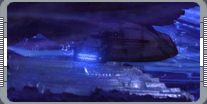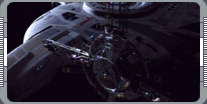
Gamma Quadrant Relay Station
Communications through the wormhole rely on a subspace filament that was caused by accident.
 Wormholes can be used as shortcuts to cover immense distances of space. The only stable wormhole known to
Starfleet and the Federation is located near the planet Bajor, and links that sector of the Alpha Quadrant with
the Gamma Quadrant. While the wormhole makes travel between two quadrants possible, it originally presented a
problem for communications: the wormhole only opens when a starship approaches to travel through. Until 2371,
subspace signals could not pass through when it was in its closed state. This meant that Federation starships
in the Gamma Quadrant were out of touch with the rest of Starfleet. Even when the wormhole was open, signals
that were sent through were so distorted by the electromagnetic interference that they were often
unintelligible. The Federation was desperate to find a way around this
Wormholes can be used as shortcuts to cover immense distances of space. The only stable wormhole known to
Starfleet and the Federation is located near the planet Bajor, and links that sector of the Alpha Quadrant with
the Gamma Quadrant. While the wormhole makes travel between two quadrants possible, it originally presented a
problem for communications: the wormhole only opens when a starship approaches to travel through. Until 2371,
subspace signals could not pass through when it was in its closed state. This meant that Federation starships
in the Gamma Quadrant were out of touch with the rest of Starfleet. Even when the wormhole was open, signals
that were sent through were so distorted by the electromagnetic interference that they were often
unintelligible. The Federation was desperate to find a way around this
 problem, as communications through the wormhole would facilitate exploration and allow Starfleet and the
Bajorans to monitor Dominion activity.
Deep Space 9's Chief of Operations Miles O'Brien and Science Officer Jadiza Dax
attempted to set up a subspace relay system that would operate through the wormhole, but their efforts met with
little success. This was partly because the phase variance in the transceiver coils, while less than 0.01%, was
too high for communications signals to get through.
problem, as communications through the wormhole would facilitate exploration and allow Starfleet and the
Bajorans to monitor Dominion activity.
Deep Space 9's Chief of Operations Miles O'Brien and Science Officer Jadiza Dax
attempted to set up a subspace relay system that would operate through the wormhole, but their efforts met with
little success. This was partly because the phase variance in the transceiver coils, while less than 0.01%, was
too high for communications signals to get through.
Despite their best efforts, Chief O'Brien and LCDR Dax were unable to find a way around all of the problems.
The situation was only resolved a year later in 2371, when three Cardassian scientists visited DS9 to work on
the project. The Cardassian team consisted of Gilora Rejal, Ulani Belor, and Dejar, an undercover agent for the
Cardassian Obsidian Order.
 The Cardassian scientists planned to place one transceiver array on a signalling platform in the Idran system, 2
kilometers from the mount of the far side of the wormhole in the Gamma Quadrant, and another in the Alpha
Quadrant on DS9. In order to accommodate the transmissions, some adjustments needed to be made to DS9's
signalling array. The Cardassians believed they could fit their transceiver inside a Federation signalling
platform and use the existing power grid to send and test various types of soliton pulse that would act as a
carrier wave. This was a similar approach to the one tried by Chief O'Brien and LCDR Dax, but the Cardassians
claimed that by using their transceiver they could halve the phase variance that had troubled Starfleet and
maintain the signal integrity. They decided to test several types of soliton pulse to determine which would be
best able to counteract the interference caused by the inside of the wormhole.
The Cardassian scientists planned to place one transceiver array on a signalling platform in the Idran system, 2
kilometers from the mount of the far side of the wormhole in the Gamma Quadrant, and another in the Alpha
Quadrant on DS9. In order to accommodate the transmissions, some adjustments needed to be made to DS9's
signalling array. The Cardassians believed they could fit their transceiver inside a Federation signalling
platform and use the existing power grid to send and test various types of soliton pulse that would act as a
carrier wave. This was a similar approach to the one tried by Chief O'Brien and LCDR Dax, but the Cardassians
claimed that by using their transceiver they could halve the phase variance that had troubled Starfleet and
maintain the signal integrity. They decided to test several types of soliton pulse to determine which would be
best able to counteract the interference caused by the inside of the wormhole.
The Cardassians found that Chief O'Brien had made many modifications to DS9's circuitry since the Federation
took over. This meant that the switching relays in Ops no longer had the same carrying
 capacity and were unable to handle the signal load of the transceiver. However, after some initial difficulties
the Cardassian scientists and Chief O'Brien were eventually able to make the necessary changes. Once the array
on DS9 was ready for operation, the USS Defiant NX-74205 deployed the
subspace relay platform in the Gamma Quadrant and targeted it at the wormhole. The relay's transceiver array
was activated, and the Cardassians attempted to send a carrier wave through the wormhole. The first wave, which
was initiated in a delta band frequency, was unsuccessful, so the Cardassians tried to send a theta band wave.
Unfortunately, this resulted in an immediate neutrino surge in the wormhole which caused it to open violently
and increased its gravity well by a factor of three. A passing silithium laden comet was subsequently pulled
toward the wormhole. This had potentially disastrous consequences: if the comet containing the silithium was
allowed to enter the wormhole, it would cause a cascade reaction and collapse the wormhole, sealing it
permanently. Attempts were made to destroy the comet using wide beam
capacity and were unable to handle the signal load of the transceiver. However, after some initial difficulties
the Cardassian scientists and Chief O'Brien were eventually able to make the necessary changes. Once the array
on DS9 was ready for operation, the USS Defiant NX-74205 deployed the
subspace relay platform in the Gamma Quadrant and targeted it at the wormhole. The relay's transceiver array
was activated, and the Cardassians attempted to send a carrier wave through the wormhole. The first wave, which
was initiated in a delta band frequency, was unsuccessful, so the Cardassians tried to send a theta band wave.
Unfortunately, this resulted in an immediate neutrino surge in the wormhole which caused it to open violently
and increased its gravity well by a factor of three. A passing silithium laden comet was subsequently pulled
toward the wormhole. This had potentially disastrous consequences: if the comet containing the silithium was
allowed to enter the wormhole, it would cause a cascade reaction and collapse the wormhole, sealing it
permanently. Attempts were made to destroy the comet using wide beam
 phasers, but these efforts were sabotages by Dejar and merely cause the comet to shatter into three pieces.
phasers, but these efforts were sabotages by Dejar and merely cause the comet to shatter into three pieces.
With no way to divert the fragments, Captain Sisko was forced to pilot a shuttle in between the fragments and
surround them with a subspace field to stop the silithium leaking out. Captain Sisko successfully navigated
through the wormhole, but there was some silithium leakage. This had the unexpected but very welcome effect of
making communications through the wormhole possible. The amount of silithium leaked was just enough to leave a
subspace filament inside the wormhole that could carry communication signals like a carrier wave.
|
|
"COMMUNICATIONS" - AUGUST 1999 ISSUE 4 STAR TREK: THE MAGAZINE COPYRIGHT OF PARAMOUNT PICTURES.
|